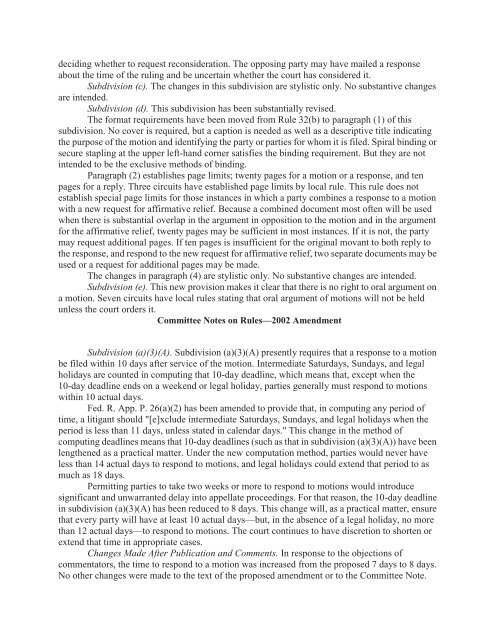Federal Rules of Appellate Procedure 2014-2015, 2014a
Federal Rules of Appellate Procedure 2014-2015, 2014a
Federal Rules of Appellate Procedure 2014-2015, 2014a
Create successful ePaper yourself
Turn your PDF publications into a flip-book with our unique Google optimized e-Paper software.
deciding whether to request reconsideration. The opposing party may have mailed a response<br />
about the time <strong>of</strong> the ruling and be uncertain whether the court has considered it.<br />
Subdivision (c). The changes in this subdivision are stylistic only. No substantive changes<br />
are intended.<br />
Subdivision (d). This subdivision has been substantially revised.<br />
The format requirements have been moved from Rule 32(b) to paragraph (1) <strong>of</strong> this<br />
subdivision. No cover is required, but a caption is needed as well as a descriptive title indicating<br />
the purpose <strong>of</strong> the motion and identifying the party or parties for whom it is filed. Spiral binding or<br />
secure stapling at the upper left-hand corner satisfies the binding requirement. But they are not<br />
intended to be the exclusive methods <strong>of</strong> binding.<br />
Paragraph (2) establishes page limits; twenty pages for a motion or a response, and ten<br />
pages for a reply. Three circuits have established page limits by local rule. This rule does not<br />
establish special page limits for those instances in which a party combines a response to a motion<br />
with a new request for affirmative relief. Because a combined document most <strong>of</strong>ten will be used<br />
when there is substantial overlap in the argument in opposition to the motion and in the argument<br />
for the affirmative relief, twenty pages may be sufficient in most instances. If it is not, the party<br />
may request additional pages. If ten pages is insufficient for the original movant to both reply to<br />
the response, and respond to the new request for affirmative relief, two separate documents may be<br />
used or a request for additional pages may be made.<br />
The changes in paragraph (4) are stylistic only. No substantive changes are intended.<br />
Subdivision (e). This new provision makes it clear that there is no right to oral argument on<br />
a motion. Seven circuits have local rules stating that oral argument <strong>of</strong> motions will not be held<br />
unless the court orders it.<br />
Committee Notes on <strong>Rules</strong>—2002 Amendment<br />
Subdivision (a)(3)(A). Subdivision (a)(3)(A) presently requires that a response to a motion<br />
be filed within 10 days after service <strong>of</strong> the motion. Intermediate Saturdays, Sundays, and legal<br />
holidays are counted in computing that 10-day deadline, which means that, except when the<br />
10-day deadline ends on a weekend or legal holiday, parties generally must respond to motions<br />
within 10 actual days.<br />
Fed. R. App. P. 26(a)(2) has been amended to provide that, in computing any period <strong>of</strong><br />
time, a litigant should "[e]xclude intermediate Saturdays, Sundays, and legal holidays when the<br />
period is less than 11 days, unless stated in calendar days." This change in the method <strong>of</strong><br />
computing deadlines means that 10-day deadlines (such as that in subdivision (a)(3)(A)) have been<br />
lengthened as a practical matter. Under the new computation method, parties would never have<br />
less than 14 actual days to respond to motions, and legal holidays could extend that period to as<br />
much as 18 days.<br />
Permitting parties to take two weeks or more to respond to motions would introduce<br />
significant and unwarranted delay into appellate proceedings. For that reason, the 10-day deadline<br />
in subdivision (a)(3)(A) has been reduced to 8 days. This change will, as a practical matter, ensure<br />
that every party will have at least 10 actual days—but, in the absence <strong>of</strong> a legal holiday, no more<br />
than 12 actual days—to respond to motions. The court continues to have discretion to shorten or<br />
extend that time in appropriate cases.<br />
Changes Made After Publication and Comments. In response to the objections <strong>of</strong><br />
commentators, the time to respond to a motion was increased from the proposed 7 days to 8 days.<br />
No other changes were made to the text <strong>of</strong> the proposed amendment or to the Committee Note.


















